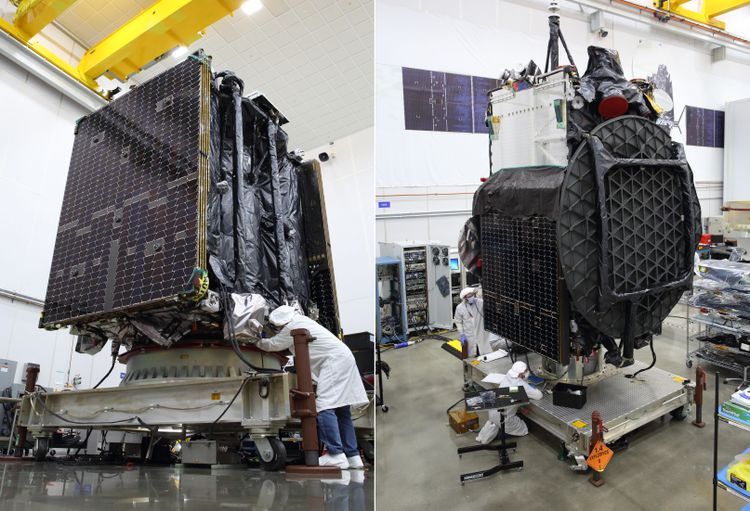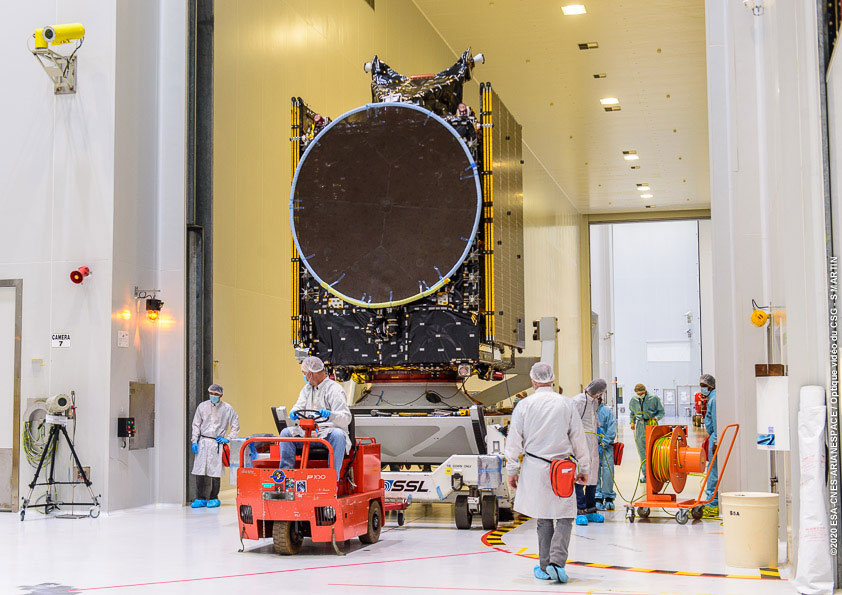Ariane 5 rocket launches robotic space tug into orbit alongside 2 communications satellites
A new space tug, only the second-ever to extend the life of older satellites, launched into orbit Saturday on a European rocket after weeks of delays due to weather and rocket checks.
An Arianespace Ariane 5 rocket hefted the Mission Extension Vehicle-2 (MEV-2) into space Sunday (July 31), putting the vehicle en route to an Intelsat satellite waiting for a boost into a higher orbit. Riding along on the rocket were two satellites for broadband communications.
The launch lifted off from the Guiana Space Center near Kourou, French Guiana at 7:04 p.m. local time (6:04 p.m. EDT or 2204 GMT), marking the fifth launch of 2020 for Arianespace.
It's been a long road for the launch. The mission was originally scheduled for July 28, but was delayed to allow "additional technical checks required under the fairing and the Ariane dual launch system," Arianespace said in a statement at the time. Bad weather prevented subsequent launch tries added a few minutes of delays to today's launch. (It was initially scheduled to lift off 31 minutes earlier at 5:33 p.m. EDT or 2133 GMT.)
Related: Arianespace Vega rocket's 53-satellite launch delayed to August

MEV-2 will continue a series of satellite servicing missions for Intelsat. The first mission, MEV-1, successfully docked with the Intelsat 901 satellite in February, marking a historic first for satellite work. The hope is that repairing and refueling aging satellites will be a cheaper venture than launching replacement satellites into space.
With Intelsat 901 back to full service in April, according to an Intelsat statement, the company is now awaiting a second opportunity. MEV-2 was developed by the Northrop Grumman subsidiary SpaceLogistics LLC.MEV-2 is expected to rendezvous and dock with the Intelsat 1002/IS-1002 satellite, originally launched in 2004, sometime in early 2021.
Get the Space.com Newsletter
Breaking space news, the latest updates on rocket launches, skywatching events and more!
The spacecraft will use its own thrusters and fuel supply to control the orbit of the IS-1002 satellite, Arianespace said in a July 8 statement. MEV-2 will be returning the satellite to a geostationary orbit, where the satellite's orbital period matches the speed of Earth's rotation. If all goes to plan, MEV-2 will then undock from the Intelsat satellite in preparation for a future mission.
Also on the Ariane 5 rocket were two satellites designed for telecommunications services.
Arianespace also launched the Galaxy 30 satellite for Intelsat as part of a larger bid to replace the aging North American Galaxy set of satellites for broadcast services. Galaxy 30 and other satellites of its group will provide services such as ultra-high definition broadcasts, over-the-top service to allow consumers to directly stream from the satellite, and a range of other services for broadband, mobile and enterprise.

The Maxar-built satellite BSAT-4b also rode into space for Japan's Broadcasting Satellite System Corp. The satellite will be used for direct-to-home services and will serve as a backup to another ultra-high definition satellite launched in 2017, called BSAT-4a.
Arianespace is marking its fifth flight of 2020 after temporarily suspending launches in French Guiana this March due to the novel coronavirus pandemic. Test flights of the successor rocket to the heavy-lift Ariane 5, called Ariane 6, will be delayed to at least 2021 due to the pandemic, the European Space Agency said this month.

"While we know that the maiden flight will not take place before the second semester of 2021, we cannot at this moment precisely quantify the delay, and we cannot provide an exact launch date," Daniel Neuenschwander, ESA's director of space transportation, said in an agency-provided translation of remarks at a July 9 press event covered by SpaceNews. ESA officials added that they hope to have more clarity on the launch date in a few months.
Follow Elizabeth Howell on Twitter @howellspace. Follow us on Twitter @Spacedotcom and on Facebook.
Join our Space Forums to keep talking space on the latest missions, night sky and more! And if you have a news tip, correction or comment, let us know at: community@space.com.

Elizabeth Howell (she/her), Ph.D., was a staff writer in the spaceflight channel between 2022 and 2024 specializing in Canadian space news. She was contributing writer for Space.com for 10 years from 2012 to 2024. Elizabeth's reporting includes multiple exclusives with the White House, leading world coverage about a lost-and-found space tomato on the International Space Station, witnessing five human spaceflight launches on two continents, flying parabolic, working inside a spacesuit, and participating in a simulated Mars mission. Her latest book, "Why Am I Taller?" (ECW Press, 2022) is co-written with astronaut Dave Williams.









